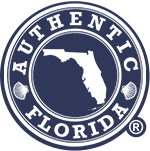Last Updated on November 3, 2023
One of the best-kept secrets and true bargains for those traveling to the Florida Keys lies in its state and national parks. An escape to the Florida Keys may be just what you need to relax and let life become what it was meant to be.
It’s a tropical destination where the feeling is definitely Caribbean. Palm trees and ocean breezes welcome the weary, and the underwater treasures of the Florida Reef offer soul-renewing world-class fishing, diving, snorkeling, and boating. If you like seafood, there’s no fresher “catch” anywhere. Accommodations range from quaint to luxurious and your choices are limitless for the perfect tropical getaway.
Distanced from urban congestion, its remote charm does not require a passport but it does make costs higher and demand greater. As a result, hotels and restaurants often trend to the “pricier” side.

Florida Keys State Parks
So you need to know the secret, especially if you are a budget-conscious traveler. True bargains can be found in the Florida Keys by taking advantage of its parks. There are plenty to choose from, but we share some of our favorites for the “real” Florida Keys experience.
Starting at John Pennekamp State Park off Key Largo, you’ll find an underwater aquarium of beautiful marine life amongst ocean blue water. Traveling mid-way through the Florida Keys, the Indian and Lignumvitae Keys off Islamorada provide history, archeological sites, and natural beauty, both available by boat. Heading to the lower Keys, travel to Bahia Honda State Park, which boasts the most beautiful beaches. And finally, an often overlooked jewel will be found at the Dry Tortugas National Park west of Key West.
John Pennekamp Coral Reef State Park, Key Largo
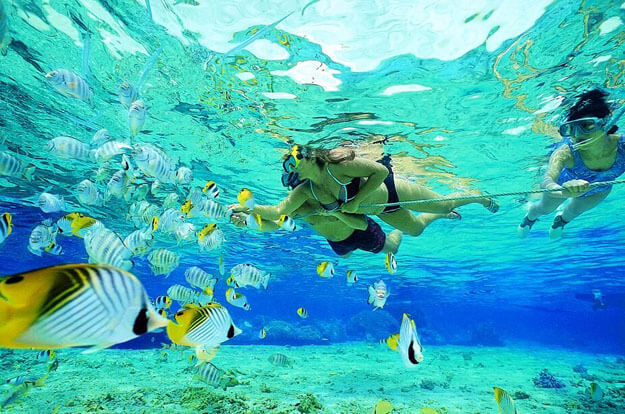
No trip to the Keys is complete without a trip to this park. The John Pennekamp State Park was the first undersea park created in the United States. It protects the only living coral reef in the continental U.S, serving as an important habitat for marine plants and animals.
What can you see at John Pennekamp Coral Reef State Park?
Approximately six miles offshore, the underwater museum is home to vibrant coral, sponges, seagrasses, and a dazzling array of over 600 species of fish, crabs, lobster, shrimp, and turtles.
Pennekamp also offers snorkel, scuba, and glass-bottom boat tours. Local, private outfitters offer trips as well. Call ahead for reservations and consider a park tour or a private dive operator for your initial visit.
Where is John Pennekamp Coral Reef State Park?
The John Pennekamp Park and Visitor Center, at Mile Marker 102.5, hosts an aquarium with engaging exhibits.
Indian Key State Park, Lower Matecombe Key
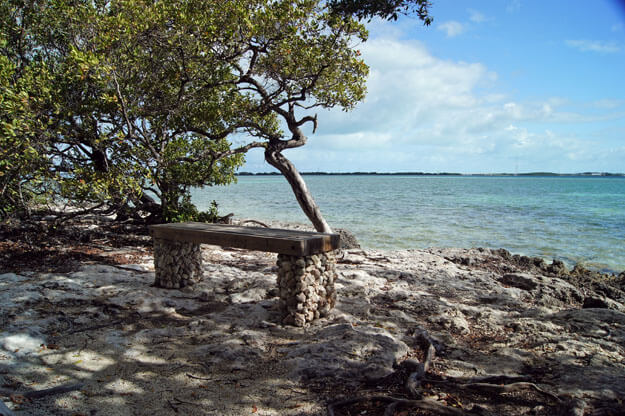
Where is Indian Key State Park?
The ten-acre Indian Key is located less than a mile from the shore of Lower Matecombe Key.
How do you get to Indian Key State Park?
It is only accessible by water, so consider renting a boat or kayak, available at Robbie’s Marina, Oceanside, Mile Marker 78.5 at 305.664.9814, or travel with a private operator. It’s an easy 20-minute kayak paddle over shallow water. Dockage and kayak landing is accessible on the west and south sides.
History of Indian Key State Park
An easy, self-guided tour circles the island with a wooden lookout tower featuring a panoramic view. The first island inhabitants were the Indians, followed by fishermen. Eventually “wreckers” took over the island as “wrecking” became a way of life in the Keys. The shallow reefs just offshore posed a hazard to shipping. Spanish vessels, caught in storms or shipwrecked on the shallow reefs carried prize cargo from the Maya, Inca, and Aztec empires.

Over time, commercial seafaring ships, plying the shipping lanes from the Caribbean, Central and South America to the eastern United States added to the wreckage, making the lucrative salvage industry a top industry in the Keys. Indian Key became the home base for Jacob Housman, an entrepreneurial salvager ostracized by a colony of Key West wreckers. He created an entire tiny island town with a store, hotel, cisterns, warehouses, and wharves. Most of the buildings were later destroyed by an Indian attack, but archaeological signs and markers remain denoting the significant landmarks.
Lignumvitae Key Botanical State Park

Where is Lignumvitae Key Botanical State Park?
This state park is also situated near Lower Matecombe Key, not far from Indian Key on the north side (bayside) of the Overseas Highway, at Mile Marker 78.5.
Wild and natural, Lignumvitae provides a rare snapshot of how the Keys once looked, and how islanders lived. On the key is the last remaining example of the virgin tropical hardwood forest that was typical of many islands in the Keys. The Lignumvitae tree (Latin for wood of life) is a dense, tough wood used for ship hulls and propeller shafts during WWII.
Unique tropical trees such as gumbo limbo, strangler figs, Jamaican dogwood, and mahogany inhabit the island. William J. Matheson from Miami purchased the island in 1919 and built a house complete with a water catchment cistern for capturing rain from the roof runoff and a windmill to supply power. The home (refurbished after various storms) is still standing and serves as the park’s visitor center today.
Touring Lignumvitae Key Botanical State Park

Ranger-guided tours are offered twice a day, Friday through Sunday. The park can be accessed via boat tours departing at 8:30 a.m. Friday-Sunday from Robbie’s Marina. Call 305.664.9814 to reserve your space. If going on your own, dockage and kayak landing is on the east side of the Key. Mosquitoes can be a bother, depending on the time of year, so it’s a good idea to bring bug spray and to wear long-sleeve shirts and pants.
Bahia Honda State Park, Bahia Honda Key

Where is the Bahia Honda State Park?
After crossing the Seven Mile Bridge, you’ll see Bahia Honda State Park at Mile Marker 37.
It’s well known for some of the best beaches in the Keys, such as the lovely Caribbean-like Sandspur Beach where emerald green water gently laps the white sandy shore. On the park’s west end Calusa Beach faces the deepest natural channel in the Florida Keys with a roped swimming area and a small marina. Nearby, the majestic old Flagler Bridge is a historical reminder of days gone by, where Henry Flagler’s Overseas Railroad has long since been replaced by the Overseas Highway.

The park’s nature trail has a rare collection of marine plants such as silver palms, yellow satinwood, and gumbo limbo. Canoes and kayaks can be rented at the concession stand and the park offers snorkeling tours to Looe Key National Marine Sanctuary. Modern cabins face the bayside and plenty of campsites are available.
The Dry Tortugas National Park

Where is Dry Tortugas National Park?
Seventy miles west of the Florida Keys lay a cluster of small coral islands called the Dry Tortugas.
Surrounded by clear turquoise water and rimmed with crystalline sandy beaches, the islands were discovered by explorer Ponce de Leon in 1513 who found the area filled with sea turtles, thus calling it Las Tortugas (The Turtles). The “dry” designation was added to warn newcomers that it was uninhabitable due to a lack of freshwater.
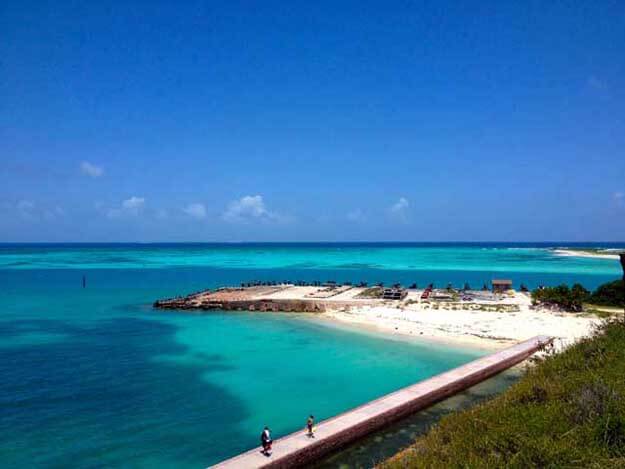
Today, this rare combination of a marine wildlife refuge, a national park, and a 19th-century historical fort in a tropical, exotic setting make it a trip you don’t want to miss while visiting the Florida Keys. As the southernmost point along the maritime U.S. shipping lanes, the Dry Tortugas became a natural location for a military outpost, the primary reason Fort Jefferson was built.
How to get to the Dry Tortugas National Park

There are a few ways to get to the Dry Tortugas. From Key West, the National Park Ferry, Yankee Freedom, a 110-foot catamaran, will take you on a full-day excursion. Private tour operators will get you there too – either by seaplane or private boat.
What can you see on the way to Dry Tortugas National Park?
The outbound trip to the island lasts two and one-half hours. You’ll pass the Marquesas Islands, Boca Grande National Bird Sanctuary, and deep sunken shipwrecks while admiring dolphins and sea turtles. Upon arriving, the ferry will dock for the day, while you get to choose from a wide assortment of things to do.
What can you see at Dry Tortugas National Park?
Hiking the fort, snorkeling the spectacular waters, relaxing on the beach, and birding for rare and unique species are just a few of the enjoyable ways to spend your day. Primitive camping is offered for those who want to stay longer.
Fort Jefferson
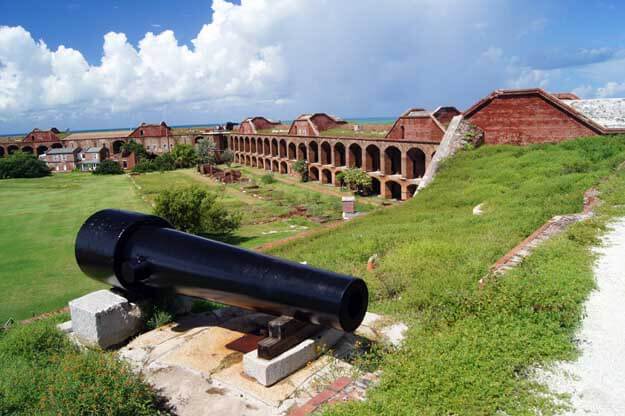
More than 16,000 red, handmade bricks make up the hexagonal (6-sided) fort. Thick eight-foot-wide walls towering 45-feet high form one of the nation’s largest masonry forts ever built.
Surrounded by a moat, this intimidating fort never actually saw active combat but was home to thousands of soldiers as well as civilian workers who lived in the remote setting. Walking through the fort, you’ll gain an appreciation for life over 150 years ago.
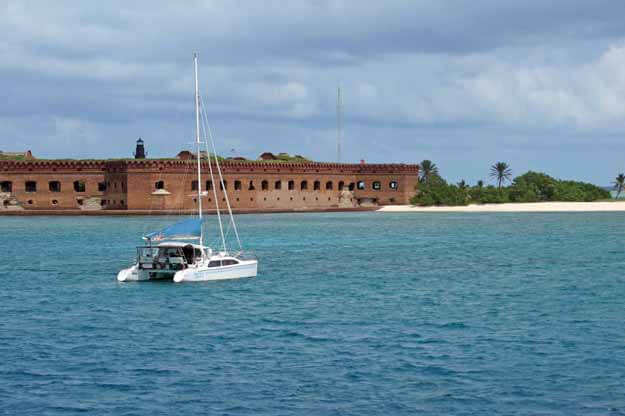
Designated as a national park in 1992, it was designed to protect the national treasures, the endangered turtles, birds, and marine life. Migrating birds use the Dry Tortugas as a key stopover so don’t forget the binoculars.
Map of Florida Keys State Parks
Finally, whether visiting the Florida Keys for pure relaxation, tasty seafood, or the wide array of water activities, you’ll enjoy a getaway filled with fun. But don’t forget to stop at the state and national parks. They make the tropics even more memorable and you just may have a little change left in your pockets.
